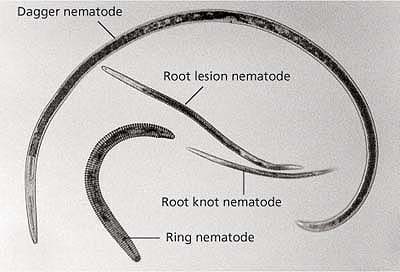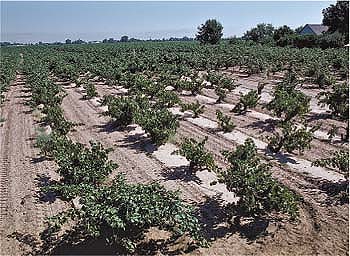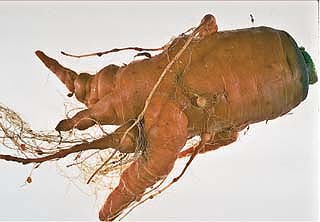All Issues
UC nematologists battle tiny underground pests
Publication Information
California Agriculture 59(2):63-64. https://doi.org/10.3733/ca.v059n02p63
Published April 01, 2005
PDF | Citation | Permissions
Full text
A variety of plant parasitic nematodes can sap nutrients from the roots of trees, vines and field crops.
Nematodes are the most numerous multicell animals on earth. One cup of soil can contain thousands of the tiny worms. Some are beneficial, but many cause significant damage to agricultural crops.
“You can see insects, and diseases often cause visible symptoms,” says Philip Roberts, a UC Riverside nematologist. “The underground feeding of nematodes can be just as harmful, but it is much more difficult to detect.”
Roberts and UC Riverside nematologist Mike McKenry who is based at the UC Kearney Research and Extension Center, preside over a specialized program that offers pest management professionals and growers the latest information on nematode problems and solutions. Their work is particularly important due to past and upcoming bans on chemicals that have traditionally been used to rid soils of nematodes before planting, such as DBCP and methyl bromide.
Perennial crops
As part of his focus on perennial crops, McKenry has pursued “chemigation” as an alternative to preplant methyl bromide soil fumigations. McKenry has developed methods and equipment that use water to carry low-fuming biocides (with short half-lives), 5 feet deep. Large volumes of water can also prevent biocides from escaping at the field surface. By 1991, he demonstrated that in highly porous soils, chemigation with biocides such as metam sodium could provide nematode control equivalent to that of methyl bromide. “Today, new products and equipment for preplant chemigation are plentiful,” McKenry says.
A promising new natural treatment for nematodes was discovered in 1979 by McKenry and his UC Riverside colleagues. The scientists identified microorganisms that were protecting five Fresno County peach orchards from root knot nematodes. The fungus, Dactylella oviparasitica, was found to be attacking the pest's eggs.
“This fungus has now been noted in other field settings and in other regions involving other nematode species,” McKenry says. “Research is slow and we still do not know how to correctly inoculate fields, but this fungus ranks as a top nematode control agent within nematode-infested soils and is naturally at work in the San Joaquin Valley.”
Another method of nematode control is the development of resistant rootstocks. In 2003, McKenry's lab released two new grapevine rootstocks that possess broad nematode resistance.
These and other advancements are of particular interest to growers who plan to replant orchards or vineyards. When land that has not previously been used to cultivate crops is converted to agricultural use, nematodes that damage trees and vines are at a minimum. After years of hosting an orchard or vineyard, however, nematodes will have colonized and reproduced to levels that would put a new planting in grave danger. This is called the “replant problem.” To address the complex issues associated with replanting, McKenry has made a 70-page report available for free on his nematode Web site.
Annual crops
Based at Kearney in the 1980s, Roberts established two experimental sites to study nematodes in annuals. The research sites were each inoculated with a distinct species of root knot nematode, the most problematic nematode on San Joaquin Valley commercial farms.
Over the last 20 years, Roberts and other scientists have identified genes that give plants natural nematode resistance, including in tomato, carrot, cotton, sugar beet and various dry grain beans. From the work at Kearney, there have been releases of several nematode-resistant black-eyed varieties, and breeder release lines of resistant carrots that are now being used by seed companies to develop commercial varieties.
Roberts has also been looking at a range of control options to avoid subjecting nematodes to selection pressure by repeatedly growing the resistant crops. He has found, for example, that crops susceptible to nematodes can be planted following some resistant crops without dramatically reducing yields. Cultural practices can also play a role, he says. “If you plant carrots at a cooler time of year, when nematodes are less active, you avoid some plant damage.”







